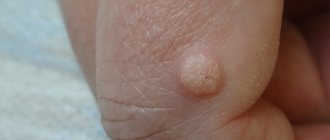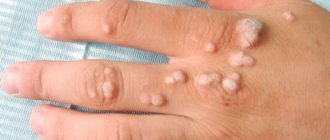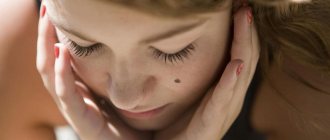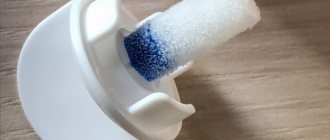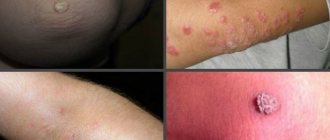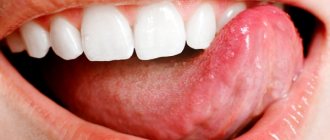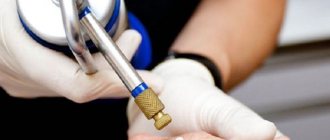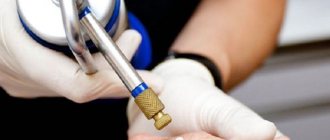Cryodestruction or exposure to liquid nitrogen is the most popular method of treating formations caused by the activity of the papilloma virus. When prescribing the procedure, patients are interested in what the wart looks like after cauterization with nitrogen. What condition of the wound is considered normal, and when it is necessary to seek help. To understand, you should study the features of skin restoration after cryodestruction.
What a wart should look like after removal with nitrogen
Wounds after wart removal using various hardware techniques differ from each other. This is due to the way each specific device influences. Destruction by nitrogen is associated with the effect of low temperature, which is inherent in gas in a liquid state.
Need advice from an experienced doctor?
Get a doctor's consultation online. Ask your question right now.
Ask a free question
During treatment, the growth becomes white and dense. This indicates the destruction of wart cells. Gradually the growth dies off and spontaneous rejection occurs. After some time, a bubble with serous fluid forms at the site of the viral formation, under which new healthy skin grows. Puncture of a blister can be harmful. In some cases, the wart may darken, indicating tissue necrosis. These conditions are considered normal and do not require auxiliary therapy. If the result is favorable, the wound will quickly heal after removal with nitrogen, and the skin will be restored.
Advantages of the method
- Quick and easy removal
. Cauterization of papilloma with liquid nitrogen is carried out quickly and does not force the patient to stay in a medical institution. After removal of the papilloma, you are immediately allowed to go home; - Painless. When eliminating formations, anesthesia is not used. However, if the papillomas are large in size or the person has sensitive skin, then anesthesia is used. The child is also treated with papillomas using anesthetics;
- Relatively low price for removal compared to other means of removing tumors;
- High percentage of those cured. Most patients who treated papillomas in the clinic with liquid nitrogen noticed their absolute disappearance. Following all the doctor’s advice reduces the risk of relapse of the disease to a minimum;
- Removal security. The procedure is bloodless, without the need for stitches;
- There are no traces after the intervention.
Rules for caring for a wound after cauterization
Rehabilitation is no less important stage of treatment than removal.
In order for the restoration of the skin to be successful, without negative consequences and complications, it is necessary to follow the rules of wound care:
- It is forbidden to wet the wound. It is not recommended to take a bath for the first 3 days after surgery.
- After starting water procedures, cover the wound with a plaster to prevent water from entering. After bathing, gently wipe the affected area with a paper towel. It is unacceptable to rub with a towel.
- Change dressing materials regularly. During treatment, use antiseptic agents to prevent dirt from entering the open wound after removal with nitrogen and blood.
- Do not touch the affected area unless necessary. This can injure the area, causing inflammation and prolonged healing.
- It is forbidden to try to cut or pick off a wart. This can lead to the development of complications, which is dangerous in the matter of wound healing and for human health.
- It is necessary to protect the growth from direct sunlight. This includes limiting your time on the beach or visiting the solarium.
- It is forbidden to pierce a bubble with liquid. Under the thin film of the blister there are ideal conditions for the growth of bacteria.
- The crust that appears after the bubble bursts is not peeled off. Otherwise, the risk of scarring or scarring increases.
- It is not recommended to use decorative cosmetics if the growth is on the face. You should avoid using aggressive hygiene products (belongings, masks).
- If the wart is located on the foot, you should limit wearing shoes. For heel wounds, you will have to give up heels and uncomfortable platforms for several months.
- Treatment after removal with nitrogen should be carried out only with products prescribed by the attending physician.
Compliance with all the rules for caring for a wart will help shorten the rehabilitation period. The growth dies off within 2 weeks. During normal healing, after nitrogen removal, the skin will be completely cleared within 1 month.
Why are papillomas dangerous?
When papillomas appear from HPV viruses, they become a source of infection of other areas of the skin, to which the viruses spread when touched. Other papillomas may also appear there. In addition, HPV increases the likelihood of skin cancer. Occasionally, papillomas can become inflamed and fester, especially after injury. The main danger comes from an incorrect diagnosis, when the name “papilloma” actually hides cancer, melanoma or precancerous diseases. Particular care should be taken with regard to “papillomas” in the lips, mouth, tongue, genitals and anal areas. Papillomas of these localizations cannot be called papillomas - they are either warts or condylomas.
Sign up for a consultation
How to treat a wart after cauterization
Proper treatment of warts after cauterization with nitrogen helps prevent the possibility of bacterial infection and speed up the healing process.
Therapeutic treatment involves the use of special antibacterial agents. They should be used until young skin appears on the wound surface. The most effective means include:
- Fukortsin is an antiseptic solution that has a pronounced antimicrobial effect. It has a bright crimson color. Treatment is carried out 1-3 times a day. Suitable for children under 12 years of age.
- Baneocin is a combined antibacterial drug. Available in powder and ointment form for local treatment. Treatment is carried out 2-4 times a day, depending on the type and scale of the lesion.
- Chlorhexidine is a solution for external treatment of wounds. Actively used in gynecology. It has an antimicrobial effect after removing the wart with nitrogen and prevents the onset of inflammatory processes. Not used in pediatrics.
- Levomekol is an ointment for treating wound surfaces after removal. The ointment contains antibiotics that suppress bacterial flora. The components of the drug enhance regenerative processes.
- Salicylic ointment has anti-inflammatory, keratolytic, antiseptic effects. It is used for treatment when the wound becomes covered with a bubble after cryodestruction. You need to smear it once every 2 days.
- Iodine is a solution intended for antiseptic treatment of wounds after removal of warts with nitrogen. The painful area is lubricated around the circumference, avoiding the solution getting into the wound itself. It is permissible to carry out treatment 2-3 times a day.
- Potassium permanganate – powder for preparing solutions. Potassium permanganate is diluted with boiled water. The solution should acquire a pale pink color; wiping off the wound surface is allowed. If the growth is located on the fingers or feet, you can make baths with potassium permanganate.
When the wound begins to heal, Contractubex (sometimes hormonal drugs) or Panavir are used to prevent scarring. The latter, in addition to its healing properties, has the ability to suppress HPV activity and restore the protective functions of the immune system.
Advantages of liquid nitrogen removal:
- The main advantage of cryodestruction is minimal trauma to the skin. Under the influence of liquid nitrogen, the wart or papilloma becomes covered with a crust, under which the cell healing process occurs. After the crust falls off, not a trace of the tumor remains on the skin. Cryodestruction is not accompanied by bleeding or pain; there is no need for preliminary preparation before removing a plantar wart or other tumors.
- The procedure is carried out quickly.
- Short recovery period.
- No further care is required for the treated skin area.
- Reasonable prices for the procedure.
Cryodestruction helps get rid of tumors such as:
- Warts
- Papillomas
- Condylomas
- Moles
- Keratomas.
This technique for removing tumors is used in cosmetology, as well as in gynecology, surgery and oncology. Cryodestruction is also used to cauterize cervical erosion and remove tonsils.
The multidisciplinary clinic "VIVO CLINIC" in Veliky Novgorod provides a wide range of medical services provided by highly qualified specialists with extensive experience.
What to do with the consequences of wart removal
Often, after eliminating a growth, a person is faced with the consequences of the procedure. Sometimes the symptoms that arise look unnatural and make you wonder whether everything is okay with the removed wart, or whether there is a need to urgently consult a doctor. After cauterization with liquid nitrogen, the patient can pay attention to changes in the shape, color and density of the growth. In order not to aggravate the healing process, a person needs to understand what actions should be taken and which ones it is better to refrain from.
A blister has appeared at the wound site, can it be pierced?
The appearance of a bubble is a normal reaction of the body to the influence of various types of external stimulus, in this case liquid nitrogen. This occurs with burns or excessive friction. Such a bubble filled with intercellular fluid is a barrier to the penetration of harmful microorganisms. As a rule, it gradually increases in size. This brings some discomfort. There may be some minor pain and pressure. It will burst on its own when the skin “ripens”.
If a water blister appears after removing a wart with liquid nitrogen, it is strictly not recommended to pierce or peel off the skin of the blister. There is a high probability of a streptococcal or staphylococcal infection entering the wound, due to which an inflammatory process will begin and pus will begin to accumulate.
The wart has turned black
The growth may turn black after exposure. This refers to normal phenomena. If the wart turns black after exposure to nitrogen, this indicates a breakdown in cellular connections. Black color indicates imminent death. You should not try to scrape off the growth until it falls off on its own. In this way, you can damage the skin or provoke a bacterial infection.
If redness appears around the wound, a strange color (blue, green) appears, or severe pain is felt, it is better to consult a doctor.
What are warts and when should they be removed?
Warts are benign growths that are formed due to the presence of the human papillomavirus (HPV) in the blood. They can be found all over the body, but are predominantly located on the face, neck, hands or soles.
Removal of a tumor is classified as a cosmetic procedure. Warts can form due to factors that lead to a malfunction in the human immune system:
- Chronic fatigue, stress and instability of the nervous system.
- Hormonal imbalances.
- Microtraumas can introduce the virus into the body.
- Increased sweating.
- You can become infected through contact with a sick person or through objects that carry the virus. With strong immunity, HPV hides and appears when immunity decreases.
Warts can cause enormous harm to the body; they can turn from a benign growth into a malignant one. They need to be monitored and removed if:
- The warts began to actively grow or change color.
- The formations interfere, cause discomfort or do not look aesthetically pleasing.
- Itching or burning appears at the site of the wart, a tear may occur, or bleeding may begin.
First aid after cryotherapy
Mistakes by a cosmetologist can negatively affect the consequences after the procedure. After removing the growths, blisters often form, which you need to be able to properly treat and not aggravate the consequences.
First aid after cryotherapy:
- anesthetize the affected area with any available means;
- disinfect with a weak solution of potassium permanganate or chlorhexidine;
- apply an ointment that promotes healing. This could be Levomikol or Tetracycline;
- apply a bandage.
If the blister has reached a large size, it must be punctured and the cavity freed from liquid.
Sequencing:
- We disinfect our hands.
- We take a sterile needle or pierce a simple needle over a fire and treat it with alcohol.
- We apply an anesthetic. This can be an ointment or an injection.
- Using a sterile needle, we make a puncture at the point where healthy skin comes into contact with the blister.
- Gently press the bubble and release the liquid from it.
- Apply ointment to the damaged area.
- We apply a bandage.
This video will tell you what to do with a blister:
If the burn blister is severe, you should consult a specialist.
Treatment of blisters
Blisters after a cryotherapy procedure are treated in two ways:
- medicinal;
- folk methods.
Drug treatment is based on treating the wound with antiseptics and introducing colloidal solutions that promote cell renewal. Antiseptics prevent the spread of viruses and bacteria, which impair the healing process and can lead to inflammation.
Important! At the first stage of treatment after the procedure, it is necessary to give preference to the medicinal method of treatment. It is more effective in a short time.
After passing the threshold of danger of the inflammatory process, you can use traditional methods of treating the blister. Let's consider step by step the medications that will be needed to remove the blister:
- After the puncture, it is necessary to relieve the inflammatory process. For this purpose, 5% dioxidine is used.
- A drug is applied to stimulate healing and cell regeneration. The best way is vitamin E. It is necessary to make compresses on the wound.
- As soon as the danger of inflammation disappears and the blister heals, it is necessary to use anti-burn ointments. You can use Levomekol, Bepanten or Levasin. Ointments do not cause burning and promote accelerated healing of the skin.
- Until complete recovery, it is necessary to use vitamins to maintain immunity.
Folk remedies
You can try to remove a blister that forms after using liquid nitrogen to get rid of warts using folk remedies.
- Inflammation is relieved with a compress.
An infusion is made from chamomile, and oak bark is taken in the same part. You will need 1 tsp. collection, everything is poured with one glass of boiling water. Cover the container and let it brew for 35 minutes. After time, apply compresses from a warm solution. Lotions can be made from infusions of plantain, yarrow and the well-known calendula. You can use only one juice from plantain, and use it to make lotions. - After the inflammation is relieved, you will need to increase the rate of cell healing. For this purpose, compresses from aloe juice are used. It has restorative properties. Carrot juice can also cope with this function.
- At the next stage, ointments are needed. They are made from plantain or calendula. The ointment is made in a 2:1 ratio, using glycerin and herbs, respectively. The resulting product is applied to the area of damage from liquid nitrogen.
- Instead of ointment, you can use mummy-based lotions. Dissolve 4g of mumiyo in 200g of hot water, not boiling water. Lotions can be carried out for three days. Accelerated cell regeneration occurs, and a film forms on the wound.
- Baths have a healing effect. They can be made from geranium oil, salt or tea tree essential oil. Add no more than 5 drops of oil or up to 2 tbsp to the water. salt. Keep the affected area of skin in warm water for at least 25 minutes. The procedure can be performed up to three times a day.
The consequences of wart removal, watch in this video:
Advice! Baths with a salt solution should not be used by people who have problems with blood pressure or diabetes.
PLANTAR WART
When working in a pedicure salon, you often encounter all possible manifestations of skin diseases, including infectious ones. Often, pedicurists meet education on the feet of clients, who are popularly called shipigs. So what is it?
Warts (Latin = verrucae) are benign infectious neoplasms of viral origin on the skin or mucous membrane. They are caused by the Human papilloma Virus (HPV), which includes up to 100 varieties. There are four types of warts: simple (verrucae vulgaris); flat or juvenile (verruca juveniles); genital (genital warts); plantar. Warts occur quite often, but in most cases they are harmless. However, the infectivity of the virus is extremely high. Due to the incubation period of 4 weeks to 18 months, it is rare that the time and location of infection can be accurately determined. In most cases, warts are spread from person to person, but there is also the possibility of transmission through contact with contaminated objects. The virus enters the human body through the smallest cracks in the skin. It feels especially favorable in a warm and humid environment. Thus, swimming pools and gyms represent the most common sites for transmission of HPV infection. Those most susceptible to infection are those with weak immune systems, those who have suffered stress, diabetics and the elderly.
If the virus affects the plantar surface of the foot, then we are talking about a plantar wart (from the Latin verruca plantaris). It is one of the most common warts and has a variety of symptoms. Plantar warts can appear individually or in large numbers. Most often, warts on the foot are the size of a pea and protrude 1-3mm above healthy skin. They are quite hard, most of the same color as the skin, and initially have a smooth surface, which becomes rougher as the wart grows. Over time, the surface of the wart changes in such a way that it looks like a cracked hyperkeratosis (excessive keratinization) of gray-yellow or gray-black color. Upon closer examination, you can often find numerous “daughter warts” around, which indicate the high infectious ability of the virus.
Rice. 1 Typical plantar wart on the heel
Warts that form in areas subject to friction and pressure are especially painful. In most cases, the surrounding skin covers the entire wart, so at first glance one can assume local hyperkeratosis or even a callus (clavus). A characteristic sign of a wart is the absence of a skin pattern. However, the wart becomes noticeable only after the keratinization is removed. Therefore, when diagnosing, you need to act with special care. Numerous black-brown dots or streaks caused by blockage of superficial capillaries can often be recognized immediately. They can be removed, but at the same time they cause numerous pinpoint bleeding - which is a special sign of the “activity” of this wart. If plantar warts appear in large numbers, then we are talking about “mosaic warts”.
Transmission of the virus occurs through infected skin cells. Therefore, the development of the disease is promoted by:
- Skin injury;
- Foot deformity;
- Incorrectly selected shoes;
- Dry skin;
- Excessive sweating.
If a person has plantar warts, the virus can spread quite quickly. Therefore, a wart on the foot must be monitored regularly in order to notice an increase in its size in time and prescribe the necessary therapy. However, spontaneous disappearance of warts is quite common. This means that even without therapeutic care, many warts disappear on their own after a few years, provided that they are not subjected to any mechanical stress in the form of friction, scratches, cutting, etc. In the case of plantar warts, this is unlikely and is due to constant wearing of shoes.
HPV infection occurs in a latent form and is particularly dangerous. This means that the virus can be detected using laboratory methods, but it is not visually detectable in the corresponding area of the skin. In this case, an apparently healthy foot can transmit the virus.
Warts of any kind should only be treated by a doctor or nurse under the supervision of a doctor.
The problem of warts cannot be solved in pedicure salons!
As already mentioned, many warts disappear on their own. But not everyone would like to wait for this for years. Therefore, urge the client to see a doctor in the following cases:
- Warts cause pain;
- Warts with a strong tendency to grow wider, such as mosaic warts;
- There is a high risk of autoinfection, for example, due to itching or due to self-medication.
Methods for removing warts include chemical, physical and general supportive therapy methods. Depending on the depth, pain and size of warts, warts can be removed using various chemical methods. For very old and deep warts, this method alone rarely leads to the desired therapeutic effect. Therefore, the pedicurist must carefully and carefully remove the stratum corneum before cauterization, as it prevents the substances from affecting the underlying wart tissue. Cauterizing agents include salicylic, acetic, retinoic acids and silver nitrate.
Rice. 2 Wart after cauterization with silver nitrate
A well-known means for physically removing warts is cryotherapy - cold treatment. We are talking about liquefied gases, which, when evaporated, freeze the wart, which leads to its destruction. The basic principle: the lower the exposure temperature, the more effective the method.
The advantages of cryotherapy are clear:
- This is a bloodless method;
- the procedure is less painful than conventional methods;
- absence of scars;
- low probability of relapse;
- targeted impact and ease of use.
Within a few days, blisters may form, which in most cases dry up on their own. If the bladder is painful, the podiatrist must open it, treat it and cover it with a dressing, and, if necessary, apply an orthosis.
Carefully! The liquid in the blister contains a virus!
Few plantar warts disappear after one treatment; most require multiple treatments. To achieve optimal effect, the patient should return after 10-14 days. Hyperkeratosis inevitably occurs at the treatment site, since this procedure always causes irritation, and the tissue tries to protect itself through increased cell formation. At the end of the cryotherapy sessions, this process returns to normal.
Rice. 3 Wart after cryotherapy
Since therapy for plantar warts is often very lengthy, prevention is of particular importance. Some supportive therapy methods significantly improve the effect, such as:
- reduction of mechanical irritation of warts (unloading correctors, orthoses, orthopedic insoles);
- normalization of sweating (local drying agents, shoes made of natural materials);
- homeopathic remedies;
- impact on reflexogenic zones;
- improving blood supply to the lower extremities;
- giving up some habits (using foot baths, etc.);
- taking immunostimulating drugs;
- Appropriate footwear must be worn in swimming pools and other common areas.
The pedicurist should tell the patient about personal hygiene:
- pumice stones, files and other similar tools are completely unsuitable for removing warts and significantly increase the risk of infection;
- the foot towel should be boiled;
- walking barefoot, and even wearing shoes on bare feet, is excluded;
- It is forbidden to open blisters on your own after cryotherapy.
When working with a client who has plantar warts, any pedicurist should always have a clear idea of what he can do. First, treat the horny formation above the wart itself. Secondly, remove the hard cushion that sometimes forms around the wart, but not completely. All your manipulations should be as precise and gentle as possible so as not to cause bleeding from the wart area. This may lead to the spread of a viral infection. After this, you need to treat the affected area with tea tree oil. Tea tree oil is a universal, long-acting antiseptic that should be on every pedicurist’s desk. The master can recommend this product to the client for home care. And all members of his family will receive means that can provide preventive protection against viral infection. Professional lines of cosmetics for feet (Peclavus, Gehwol, Yards, etc.) are optimal for this.
The more you talk with the client, the more he trusts you, feeling your professionalism. To support your procedures, you can recommend one of the traditional recipes to the client. The most common way to treat warts: take a piece of cotton wool slightly larger than the area of the wart, rub laundry soap “dissolved” in water into it and secure it with a bandage on the wart. The patch should be large so that it does not move when walking. After a day, remove the patch - the softened wart is easily separated from healthy skin. If it is large enough and it cannot be completely removed, then the procedure should be repeated.
If it happens that folk remedies did not help your client, you, as a competent specialist, can recommend a medical center that specializes in this problem.
When working with any infection, the master must use protective equipment (gloves and masks), properly disinfect the skin before and after the procedure, sterilize the instrument and immediately dispose of disposable materials!
Elena PANOVA, doctor - mycologist, methodologist Ekaterinburg 2005
Prices for radio wave removal of warts
| Removal of 1 wart (digital dermatoscopy 750, removal 2150, anesthesia 550, histology 1500, free consultation on the day of treatment) | 4950 rub. |
| Removal of 2 warts (digital dermatoscopy 750, removal 4300, anesthesia 1100, histology 3000, free consultation on the day of treatment) | 9900 rub. 9150 rub. ( 8% discount |
| Removal of 3 warts (digital dermatoscopy 750, removal 6450, anesthesia 1650, histology 4500, free consultation on the day of treatment) | 14850 rub. 13350 rub. ( 11% discount |
If you are reading these lines, then you probably have a wart, or even several, on the skin of your face or body and you want to get rid of them.
- Do you think that a wart makes you less attractive?
- Because of a wart in your armpit, you now wield a razor like a professional barber?
- Do warts on your back make it difficult
to wear a bra? - Instead of playing sports and active recreation, are you thinking about how to avoid accidentally damaging a wart?
- At the beach, do you cover up skin lesions with a band-aid and are afraid of sunbathing?
- Tired of touching the wart with your hand
or clothes, and are you thinking about getting rid of it for the hundredth time?
Read this text to the end and you will learn how to get rid of unwanted warts without scars and 100% safely in one visit.
Causes
HPV (human papillomavirus) is to blame for the occurrence of warts. It can be transmitted through personal contact through contact with a carrier of the virus; sometimes a single handshake may be enough. The infection can also often be acquired in public places (for example, a swimming pool, gym, sauna). Other risk factors include: working with toxic substances, stress and constant negative emotions, microtrauma, excessive sweating.
Benefits not related to removal technique
- Honest prices.
No hidden fees or intrusive services. Either consultation or removal is paid, strictly according to the price list. You can always check the price with me on VKontakte by sending a photo with a ruler in the background. - Free information support before and after surgery.
If you have any doubts before your visit, you can easily and free of charge by mail or VKontakte. After the operation, you will have my personal phone number, by which you can ask me at any time about what is bothering you. - Fast and convenient:
- Online appointment booking and removal without calls or waiting
- No preliminary tests, dressings, or suture removal required
- Histology results by email
. You can read them on these sites: docplanner.ru (more than 40 reviews), napopravku.ru (24 reviews), vk.com (more than 150 reviews)

